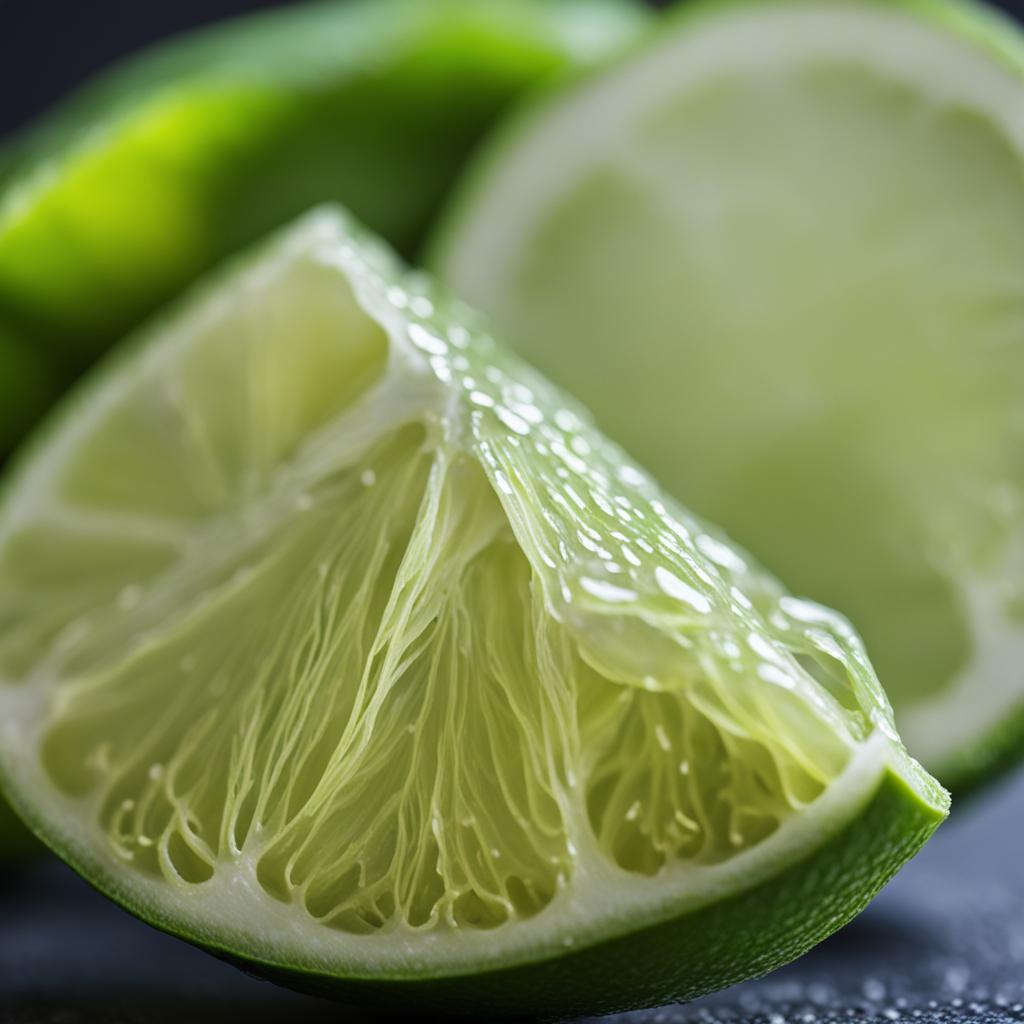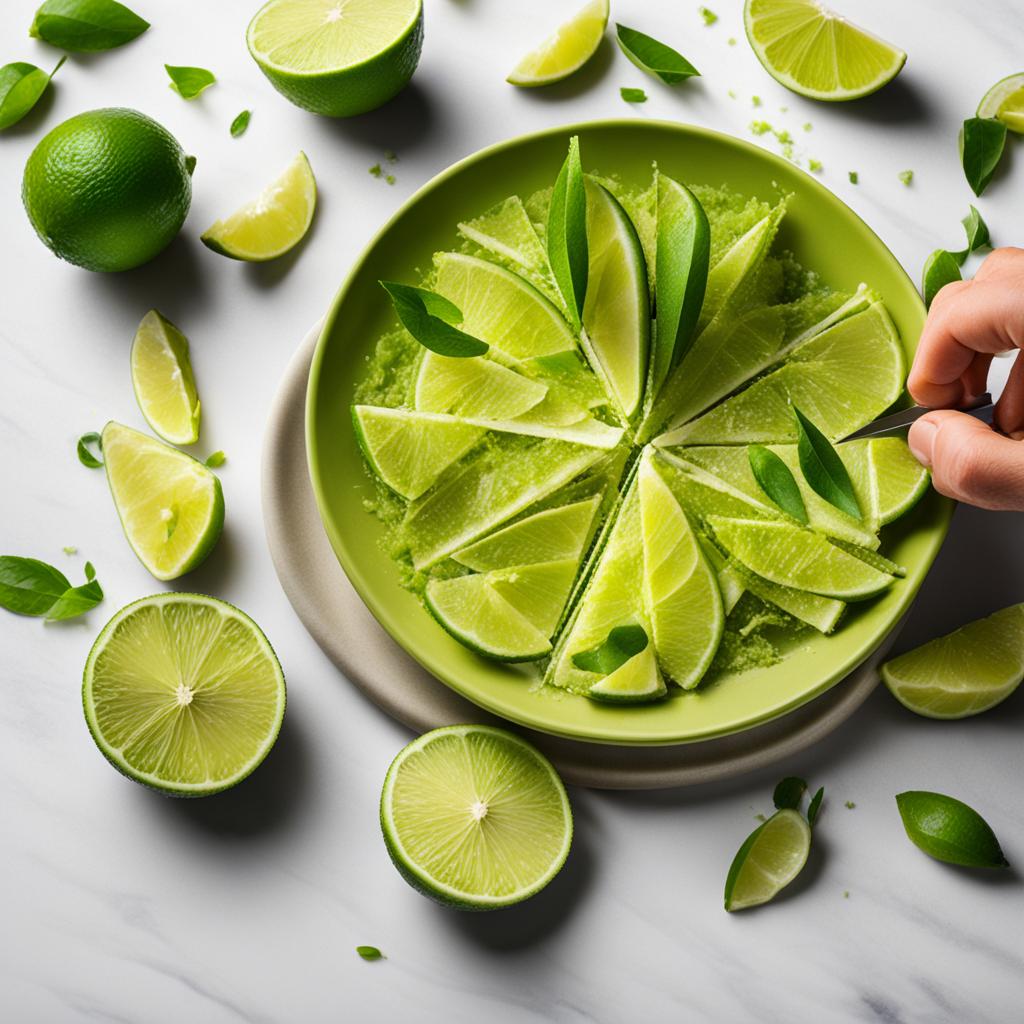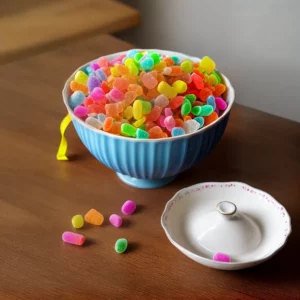Are you ready to add a burst of tangy and aromatic flavor to your culinary creations? Look no further than lime zest, a versatile ingredient that can elevate your cooking to new heights. In this article, I will guide you through everything you need to know about lime zest, from zesting techniques to preserving its freshness. Let’s dive in!
Key Takeaways:
- Lime zest is the colored outer part of the lime peel, rich in flavor and aroma.
- It can be obtained using tools like a microplane, box grater, vegetable peeler, or knife.
- Lime zest is a popular ingredient in desserts, sauces, dressings, beverages, and more.
- It offers not only a bright citrus flavor but also vitamins and antioxidants.
- To preserve lime zest, store it in the fridge, freeze it, or air dry it.
What is Lime Zest?
Lime zest is a citrus ingredient that adds a tangy and flavorful punch to various culinary creations. It is derived from the colored outer part of the lime peel, which harbors concentrated oils and flavors. With its bright and aromatic qualities, lime zest serves as an excellent substitute for lime juice. It offers a more intense flavor that can enhance the taste of numerous recipes.
When using lime zest, it is crucial to utilize the colored part of the peel while avoiding the bitter white pith. The zest can be grated finely using a microplane, a box grater, or a vegetable peeler. Each method offers distinct results in terms of zest texture and thickness. Whether you’re looking to add a zesty twist to savory or sweet dishes, lime zest delivers a concentrated burst of citrusy goodness.
Lime zest packs a punch of tangy flavor and citrusy goodness. It’s like adding a concentrated dose of lime to your dishes, elevating their taste and aroma. Whether in desserts, sauces, or dressings, lime zest is a culinary gem that can take your recipes to new heights.
The Flavorful Versatility of Lime Zest
Table: Lime Zest Uses in Culinary Applications
| Recipe Type | Examples |
|---|---|
| Desserts | Pies, tarts, cheesecakes |
| Beverages | Cocktails, teas, infused water |
| Sauces and dressings | Salsa, vinaigrettes, marinades |
| Savory dishes | Seafood, poultry, stir-fries |
Lime zest is a versatile ingredient that can be used in various culinary applications. Its bright and tangy flavor adds a refreshing and citrusy note to desserts, including pies, tarts, and cheesecakes. In beverages, lime zest works wonders in cocktails, teas, and infused water, providing a burst of tanginess. When it comes to sauces and dressings, lime zest elevates the flavors of salsa, vinaigrettes, and marinades. Even in savory dishes like seafood, poultry, and stir-fries, lime zest adds a zesty and aromatic touch.
- Provides a tangy and vibrant flavor.
- Enhances the taste of various recipes.
- Offers a versatile citrus ingredient.
- Serves as a substitute for lime juice.
In addition to its flavor-enhancing properties, lime zest also offers several health benefits. It is packed with vitamins and antioxidants, contributing to overall well-being. Incorporating lime zest into your cooking not only adds a zesty kick but also provides nutritional value.
How to Zest a Lime
Zesting a lime is a simple process that can be done using different tools. The most common methods include using a microplane, a box grater, a vegetable peeler, or a knife. The microplane is a popular choice for achieving fine zest, while a box grater can also be used for similar results. A vegetable peeler can be used as an alternative, although it may require more effort. Care should be taken to remove only the colored part of the peel, as the white pith can impart a bitter taste.
When using a microplane, hold the lime firmly and gently run the lime over the surface of the microplane, applying light pressure. The sharp blades of the microplane will grate off the colored zest, leaving behind the white pith. Rotate the lime as you zest to ensure even coverage.
For a box grater, choose the side with the finest holes and grate the lime against the surface, similar to using a microplane. Be cautious of your fingers when grating, as the blades of the grater are sharp.
If you prefer using a vegetable peeler, carefully peel off the colored part of the lime peel, avoiding the white pith. Once you have removed the zest, you can finely chop it using a knife.
How Much Zest Can You Get from a Lime?
When it comes to zesting a lime, you might be wondering how much zest you can actually get from this small citrus fruit. The answer depends on the size of the lime, but on average, a regular-sized lime can yield about 2 teaspoons of lime zest. This measurement is helpful when following recipes that call for lime zest, as it gives you an idea of how many limes you’ll need to achieve the desired amount.
Calculating the amount of lime zest you need can be a straightforward process. If a recipe calls for 1 tablespoon of lime zest, you would need approximately 6 regular-sized limes. Keep in mind that these measurements are estimates and can vary slightly depending on the juiciness and size of the limes you use.
To ensure accuracy when measuring lime zest, it’s best to use a fine grater or microplane. These tools allow you to easily extract the thin strips of zest from the lime peel, capturing the aromatic oils and flavors. Remember to only grate the colored part of the peel, avoiding the bitter white pith beneath.
| Amount of Lime Zest | Approximate Number of Limes |
|---|---|
| 1 teaspoon | 1/2 lime |
| 1 tablespoon | 3-4 limes |
| 1/4 cup | 8-10 limes |
Key Takeaways:
- On average, one regular-sized lime yields approximately 2 teaspoons of lime zest.
- When a recipe calls for lime zest, it is helpful to know that 1 tablespoon of zest requires around 3-4 limes.
- Using a fine grater or microplane ensures accurate and consistent measurements.
Different Tools for Zesting
When it comes to zesting a lime, there are several tools available that can make the process quick and easy. Whether you prefer a microplane, a box grater, or a vegetable peeler, each tool has its advantages and can produce excellent results.
The microplane is a popular choice among chefs and home cooks alike. Its sharp holes allow for precise and consistent zesting, resulting in fine shreds of lime zest. The microplane is also versatile and can be used for grating other ingredients like cheese or chocolate.
If you don’t have a microplane, a box grater with fine holes can also be used for zesting. Simply rub the lime against the grater’s surface to collect the zest. While the results may not be as fine as with a microplane, the box grater is a common kitchen tool that can get the job done.
For those who don’t have specialized zesting tools, a vegetable peeler can be a handy alternative. Although it requires more effort and may not produce as fine shreds of zest, a vegetable peeler can still effectively extract the zest from the lime peel.
Table: Comparison of Zesting Tools
| Tool | Advantages | Disadvantages |
|---|---|---|
| Microplane | – Precise and consistent zesting | – May require a bit of practice to master |
| Box Grater | – Can produce fine zest | – Results may not be as fine as a microplane |
| Vegetable Peeler | – Handy alternative if you don’t have specialized tools | – Requires more effort and may not produce fine shreds |
Uses for Lime Zest
When it comes to culinary applications, lime zest is a versatile ingredient that can lend its bright and tangy flavor to a wide variety of dishes. Whether you’re cooking, baking, or making sauces, marinades, dressings, beverages, or cocktails, lime zest can be a fantastic addition that adds a burst of citrusy goodness.
When used in desserts like cakes, cookies, and pies, lime zest can provide a refreshing twist and enhance the overall flavor profile. It adds a unique brightness and complexity that elevates the taste experience. Lime zest can also be a great addition to savory dishes, adding a tangy kick to sauces, marinades, and dressings. Its vibrant flavor can help balance out other ingredients and bring a refreshing element to the dish.
Furthermore, lime zest can be a delightful garnish for beverages and cocktails, offering a beautiful aroma and a burst of citrus flavor with each sip. It can add a touch of elegance and sophistication to your drinks, making them look and taste even more enticing. Whether you’re enjoying a refreshing lime-infused tea or a zesty lime-flavored martini, lime zest can take your beverages to the next level.
| Uses of Lime Zest | Description |
|---|---|
| Desserts | Adds a refreshing twist and enhances the overall flavor profile of cakes, cookies, and pies. |
| Sauces, Marinades, and Dressings | Provides a tangy kick and a bright flavor to balance out other ingredients in savory dishes. |
| Beverages and Cocktails | Serves as a delightful garnish, adding a burst of citrus flavor and aroma to drinks. |
Whether you’re looking to enhance the flavor of your culinary creations or simply brighten up your dish with a tangy and aromatic touch, incorporating lime zest is a fantastic choice. Experiment with different recipes and discover the endless possibilities that lime zest brings to the culinary world.

Benefits of Lime Zest
When it comes to culinary arts and food knowledge, lime zest is a secret weapon that adds a burst of flavor to dishes. But did you know that lime zest also offers several health benefits? Rich in vitamins and antioxidants, incorporating lime zest into your cooking not only enhances the taste of your dishes but also provides additional nutritional value.
Vitamins: Lime zest is packed with essential vitamins, including vitamin C, vitamin A, and vitamin E. These vitamins play a vital role in supporting overall health, boosting the immune system, and promoting healthy skin.
Antioxidants: Lime zest is also a great source of antioxidants, which help protect the body against free radicals and reduce the risk of chronic diseases. Antioxidants are known for their anti-inflammatory properties and can contribute to improved heart health and brain function.
“Incorporating lime zest in your cooking can not only enhance the taste of your dishes but also provide additional nutritional value.”
So, the next time you’re cooking with lime zest, remember that you’re not just adding a burst of flavor to your dish – you’re also boosting your health with a dose of vitamins and antioxidants.
Table:
| Vitamins | Antioxidants |
|---|---|
| Vitamin C | Protects against free radicals |
| Vitamin A | Supports healthy skin |
| Vitamin E | Boosts the immune system |
Preserving Lime Zest
When it comes to lime zest, proper storage is key to maintaining its freshness and flavor. Here are some tips on how to preserve lime zest:
Refrigeration:
For short-term storage, place the lime zest in an airtight container and store it in the refrigerator. This will help prolong its freshness for up to two weeks. Make sure to label the container with the date to keep track of its freshness.
Freezing:
If you want to store lime zest for a longer period, freezing is a great option. You can freeze lime zest in its whole form or grate it and portion it into ice cube trays for easy use. Simply place the zest in a freezer-safe bag or container and store it in the freezer. Frozen lime zest can be used directly in recipes without thawing.
Drying:
Another method to preserve lime zest is by drying it. Spread the zest out on a baking sheet and allow it to air dry until it becomes crisp. Once dry, store it in an airtight container in a cool, dark place. Dried lime zest can be used as a seasoning or garnish in various dishes.
By following these preservation methods, you can ensure that your lime zest stays fresh and flavorful, ready to enhance your recipes whenever you need it.
Recommended Kitchen Tools for Zesting
When it comes to zesting a lime, having the right tools can make all the difference in achieving the perfect zest. Here are some recommended kitchen tools that can help you zest your lime with ease and precision.
1. Microplane
The microplane is a must-have tool for any kitchen enthusiast. Its sharp blades and small grating holes make it ideal for extracting fine zest from the lime peel. Simply run the lime across the grating surface of the microplane, and watch as the zest collects effortlessly. The microplane is not only perfect for lime zest, but it can also be used for grating other ingredients like cheese and spices.
2. Box Grater
If you don’t have a microplane, a box grater can also do the job. Choose a box grater with fine holes and use the side with the smallest holes to zest your lime. Hold the lime firmly and rub it against the grater in a downward motion. The zest will collect in the holes of the grater, ready to be added to your favorite recipes.
3. Vegetable Peeler
If you don’t have access to specialized zesting tools, a vegetable peeler can be a handy alternative. While it may require more effort compared to a microplane or box grater, a vegetable peeler can still effectively extract the zest from the lime. Use the peel with caution to remove only the colored part, avoiding the bitter white pith.
With these recommended kitchen tools, zesting a lime becomes a breeze. Whether you prefer the precision of a microplane, the versatility of a box grater, or the simplicity of a vegetable peeler, these tools are sure to elevate your zesting game and help you achieve the perfect lime zest for your culinary creations.
Enhancing Recipes with Lime Zest
When it comes to culinary creativity, lime zest is a secret ingredient that can take your recipes to the next level. The bright and tangy flavor of lime zest adds a refreshing twist to a wide range of dishes, making it a versatile tool in the kitchen. Whether you’re baking a cake, preparing a savory sauce, or mixing up a cocktail, incorporating lime zest can provide a delightful flavor boost that elevates your creations.
With its citrusy essence, lime zest brings a burst of freshness and acidity to your recipes. It adds a zingy punch that complements both sweet and savory dishes. Sprinkle a touch of lime zest on top of a tangy key lime pie to enhance the citrus flavor, or mix it into a marinade for grilled shrimp to add a bright and aromatic note. The possibilities are endless, and experimenting with lime zest can lead to exciting new flavor combinations.
Not only does lime zest enhance the taste of your dishes, but it also adds visual appeal. The vibrant green color of lime zest can be used as a garnish to create an eye-catching presentation. Whether you sprinkle it over a salad, use it to rim a cocktail glass, or add it as a finishing touch to a dessert, lime zest adds a pop of color that pleases both the eyes and the taste buds.
Table: Recipes Enhanced with Lime Zest
| Recipe | Description |
|---|---|
| Lime Zest Sugar Cookies | These buttery cookies are infused with the tangy flavor of lime zest, creating a delightful twist on a classic recipe. |
| Lime Zest Grilled Chicken | Marinating chicken in a mixture of lime zest, garlic, and spices adds a zesty kick to your grilled dishes. |
| Citrus Lime Tart | A creamy and tangy lime tart made with fresh lime zest and a buttery graham cracker crust. |
So, the next time you’re looking to add a burst of flavor to your recipes, reach for some lime zest. Its bright and citrusy notes can enhance the taste and presentation of your culinary creations. Get creative and experiment with different dishes, and let the refreshing flavor of lime zest bring a little zest to your cooking.
Tips from Expert Chefs
As an experienced chef, I’ve learned a few valuable tips and techniques when it comes to using lime zest in culinary arts. Proper food preparation is crucial to ensure the best results. Before zesting the lime, make sure to wash and dry it thoroughly. This helps remove any dirt or contaminants that may affect the flavor of the zest. When zesting, it’s important to grate only the colored part of the peel, avoiding the bitter white pith underneath.
Cooking techniques play a significant role in achieving the desired flavor. For a more subtle lime flavor, use larger, coarser zest pieces. If you want a stronger lime taste, opt for finely grated zest. The size and texture of the zest can significantly impact the overall flavor profile of your dish. It’s also essential to consider the quantity of zest you add. Start with a small amount and taste as you go, adding more if desired.
“Zesting lime requires precision and attention to detail. Always use a sharp tool and apply steady pressure to get beautiful zest without any bitter white pith.” – Chef Emily
Quality assurance is key when it comes to selecting the right limes for zest. Look for limes that are firm and heavy for their size, as they tend to have more juice and zest. Avoid limes with blemishes or soft spots, as they may affect the flavor and quality of the zest. By following these expert tips, you can elevate your dishes with the vibrant and tangy flavor of lime zest.

Exploring Other Citrus Zests
While lime zest is a popular choice in the kitchen, there is a world of citrus zests waiting to be explored. Citrus fruits like limes, grapefruits, and oranges offer their own unique zest flavors that can elevate your culinary creations to new heights. Each citrus zest has its distinct characteristics, adding a different dimension of flavor to your dishes.
Delicious Zest Flavors
Let’s take a closer look at the zest flavors of different citrus fruits:
- Lime Zest: Known for its tangy and bright flavor, lime zest adds a refreshing citrus kick to recipes. It pairs well with both sweet and savory dishes, making it a versatile choice for enhancing various culinary creations.
- Grapefruit Zest: Grapefruit zest has a slightly bitter and floral flavor profile. It can provide a zesty burst to desserts, cocktails, and savory dishes, balancing out the sweetness or adding a unique twist.
- Orange Zest: Orange zest is known for its sweet and aromatic characteristics. It adds a delightful burst of flavor to baked goods, desserts, and savory dishes, complementing the other ingredients with its citrusy notes.
By incorporating different citrus zests into your recipes, you can experiment with a wide range of flavors and create dishes that excite the taste buds. Whether you’re looking for a tangy kick or a subtle hint of citrus, exploring other citrus zests opens up a world of possibilities in the kitchen.
| Citrus Fruit | Zest Flavor |
|---|---|
| Lime | Tangy and bright |
| Grapefruit | Slightly bitter and floral |
| Orange | Sweet and aromatic |
Table: Different citrus zests and their flavor characteristics.
Conclusion
In conclusion, lime zest is a versatile and flavorful ingredient that can elevate your cooking and add a tangy and aromatic touch to a wide range of recipes. Whether you use a microplane, box grater, vegetable peeler, or knife, learning how to zest a lime opens up a world of culinary possibilities.
From desserts to savory dishes, lime zest can enhance the flavors and bring a refreshing citrus taste to your creations. Its versatility allows it to be used in various culinary applications, including cooking, baking, sauces, marinades, dressings, beverages, and as a garnish for cocktails and teas. Lime zest is truly a versatile ingredient that can take your recipes to the next level.
So why not experiment with lime zest in your next culinary adventure? Try adding it to your favorite recipes and experience the bright and vibrant flavors it brings to your cooking. Get creative and explore the countless ways lime zest can enhance the flavors and elevate your dishes. Lime zest is a must-have ingredient in any culinary enthusiast’s kitchen, offering a burst of flavor that will leave your taste buds wanting more.
FAQ
What is lime zest?
Lime zest refers to the colored outer part of the lime peel, which contains the concentrated flavors and oils of the citrus fruit.
How do you zest a lime?
You can zest a lime using a microplane, a box grater, a vegetable peeler, or a knife.
How much zest can you get from a lime?
On average, one regular-sized lime can yield approximately 2 teaspoons of lime zest.
What are the different tools for zesting?
The different tools for zesting include a microplane, a box grater, a vegetable peeler, and a knife.
What are the uses for lime zest?
Lime zest can be used in a variety of culinary applications, such as desserts, cakes, cookies, sauces, marinades, dressings, and beverages.
What are the benefits of lime zest?
Lime zest is a rich source of vitamins and antioxidants, which can contribute to overall well-being.
How can you preserve lime zest?
Lime zest can be stored in the refrigerator in an airtight container for up to two weeks, frozen, or dried.
What are the recommended kitchen tools for zesting?
The recommended kitchen tools for zesting include a microplane, a box grater, and a vegetable peeler.
How can you enhance recipes with lime zest?
Adding lime zest to your recipes can provide a citrusy and tangy kick that brightens up various culinary creations.
What tips do expert chefs have for using lime zest?
Expert chefs recommend proper food preparation, using the right zesting techniques, and selecting fresh limes for optimal zest flavor.
Are there other citrus zests that can be used?
Yes, citrus fruits such as lemons, grapefruits, and oranges offer their own unique zest flavors that can be used to enhance various dishes.
Source Links
- https://www.acouplecooks.com/how-to-zest-a-lime/
- https://www.taketwotapas.com/how-to-zest-a-lime/
- https://www.culinaryhill.com/how-to-zest-a-lime/
Related Recipes:
 Lime Zest Substitutes for Your Cooking Needs
Lime Zest Substitutes for Your Cooking Needs
 All About Lemon Zest: How to Use It
All About Lemon Zest: How to Use It
 Lemon Zest Substitute: Best Alternatives
Lemon Zest Substitute: Best Alternatives
 How to Grate Cheese Without a Grater: Innovative Approaches
How to Grate Cheese Without a Grater: Innovative Approaches
 How to Peel an Apple: Quick and Efficient Techniques
How to Peel an Apple: Quick and Efficient Techniques
 How to Store Citrus Fruits for Best Flavor
How to Store Citrus Fruits for Best Flavor
 How to Peel Ginger: Techniques for Fresh and Dried
How to Peel Ginger: Techniques for Fresh and Dried
 How to Peel Potatoes: Quick Tips for Different Types
How to Peel Potatoes: Quick Tips for Different Types








